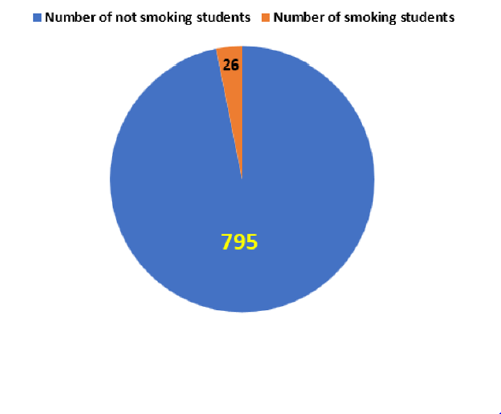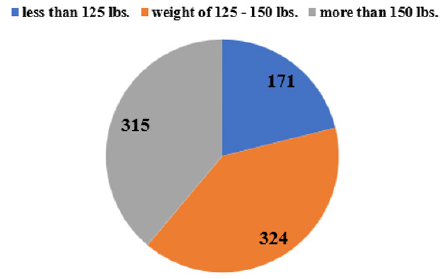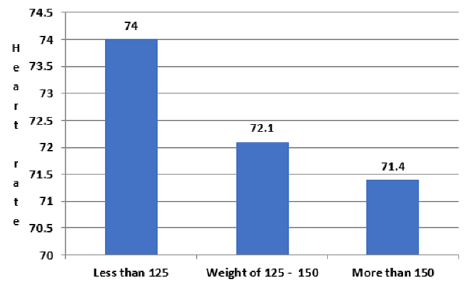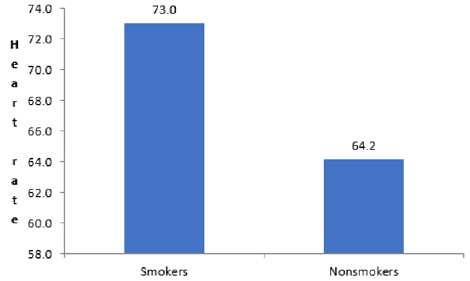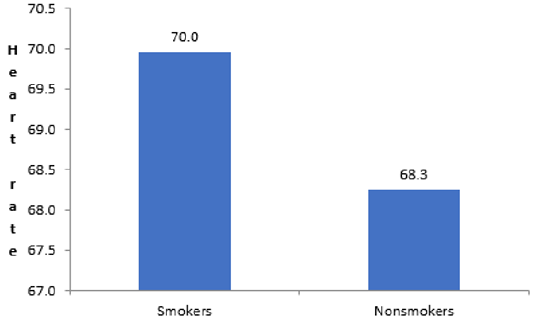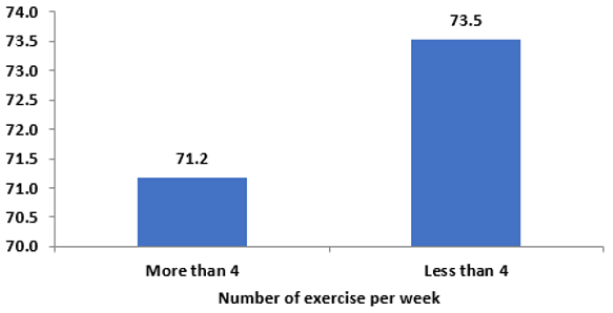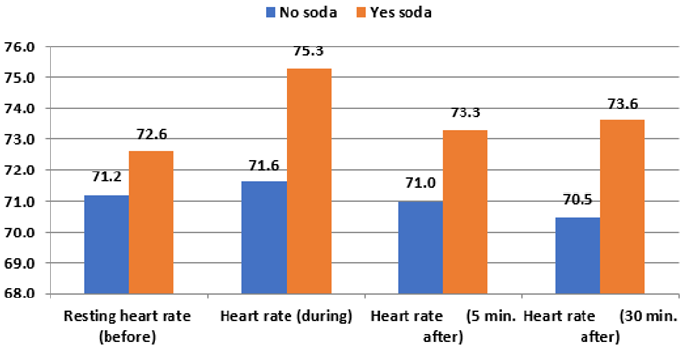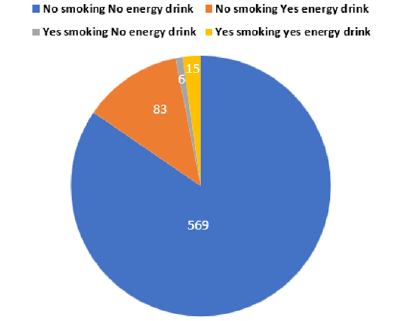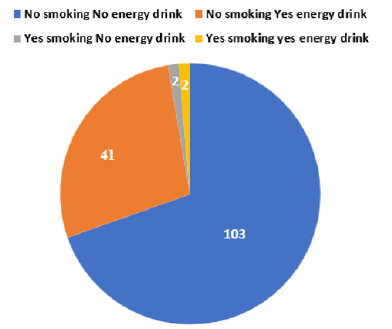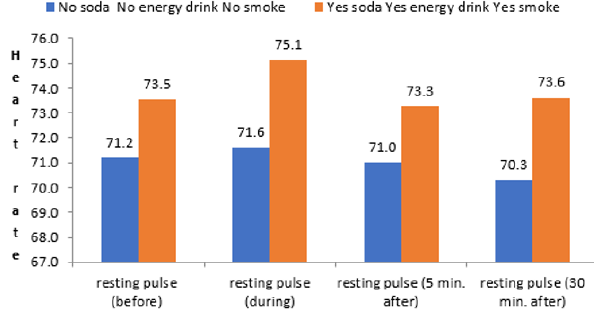Abstract
Introduction: There is association between health and heart rate. Resting heart rate is a simple measurement with prognostic implications. Smoking, drinking sodas and/ or energy drinks may increases the risk of developing cardiovascular diseases, which includes coronary heart disease.
Study Purpose: The present study was conducted to assess the complementary impact drinking energy or soda, exercise, smoking and body weights on heart beats, as easiest method of assessing cardiovascular dysfunction.
Material and Methods: The study included a sample of 810 female and male subjects randomly selected from the population of healthy students at Grand Canyon University, their ages ranged between 17-46 years (with average age of 19.5 ± 1.3 years). Detailed information was recorded including personal details age, smoking habit, and physical activity practiced. Heart rate was recorded on the selected subjects. Categorical data was analyzed by Chi-square test. A P value of 0.05 or less was considered a statistical significance.
Results: Smoking, soda and energy drinks, exercise and body weight had no statistically significant influence on heart rate.
Conclusion: The non-significant effects of smoking, soda and energy drinks, exercise and body weight on heart rate may be due to that subjects under this investigation were young students, and they have a fast recovery of the impact of the studied variables.
Keywords: Heart Rate; Smoking; Energy Drink; Soda; Exercise; Body Weight
Introduction
Resting heart rate is the number of times heart beats per minute when persons are at rest and heart is pumping the lowest amount of blood to supply the oxygen body’s needs. A normal resting heart rate is usually 60-100 beats per minute and varies from person to person. A lower resting heart rate is generally means your heart is healthy and in good condition. Knowing heart rate can be an important gauge of heart health. While a higher resting heart rate is generally linked with a sedentary lifestyle, higher blood pressure, and body weight, there is a wide range of normal. An unusually high or low heart rate may indicate an underlying problem regardless of fitness level and may increase the risk of heart disease and premature death. Heart disease is when the blood vessels that supply the heart with blood narrow, increasing the risk of a heart attack, angina and stroke. A heart attack is when the artery is blocked; preventing blood from getting through, and an ischemic stroke is when a blood vessel in the brain becomes blocked in a similar way [1]. Heart rate, HR (heart rate, PR) changes from time to time. It depends on whether persons are standing up or lying down, moving around or sitting, stressed or relaxed. Resting heart rate, though, tends to be stable.
The usual range for resting heart rate is 60-90 beats per minute. Above 90 is considered high. Results of research indicated that there was association between health and heart rate. Many factors influence resting heart rate. Genes play a role, advanced age tends to speed it up, exercise (walk, swim), stress, smoking, emotions (stress, anxiety, fear), environmental temperature, dehydration, drugs and body weight (heavy body tends to have more heart rate to supply it with blood) [1-3]. Smoking increases the risk of developing cardiovascular diseases, which includes coronary heart disease and stroke. Smokers had significantly higher resting HR values than non-smokers. Both female and male smokers showed a significantly slower HR increase during exercise [4,5]. Resting heart rate is a simple measurement with prognostic implications. High resting heart rate was noted in smokers as compared to nonsmokers [6].
The main aim of this study was planned to assess and compare resting heart rate response in smokers and nonsmokers. Also, the present study was conducted to assess the effect of the complementary impact soda drinking, exercise, smoking and body weights on heart beats, as easiest method of assessing cardiovascular dysfunction.
Materials and Methods
Study Design
The study included a sample of 810 female and male subjects randomly selected from the population of healthy students at Grand Canyon University, their ages ranged between 17-46 years (with average age of 19.5 ± 1.3 years). They were divided into two groups: the first group comprising of 795 nonsmokers and the second group included 26 smokers (Nonsmokers were more prevalent than smokers, Figure 1).
Detailed information was recorded including personal details like name, age, address, smoking habit, and physical activity practiced. Heart rate was recorded on the selected subjects. Heart rate of all subjects was taken before, during, 5 min. after soda/or energy drink and 30 min. after drinks. Heart rates were taken from wrists, inside of elbow by putting the finger over heart and count the number of beats for full one minute.
Statistical Analysis
Data was analyzed by Chi-square test using GraphPad Software [7]. A P value of 0.05 or less (p < 0.05) was considered for statistical significance
Results
Number of students in the categorized weight groups was presented in Figure 1. Number of students in the categories “less than 125 lbs.”, “125-150 lbs.”, and “more than 150 lbs.” were 171(21.11%), 324 (40.00%), and 315 (38.89%), respectively (Figure 2). Statistical analysis showed that number of student group of less than 125 lbs. was significantly less frequent compared to other categorized groups, P = 0.0001. In this present study it was noted a non-significant (P = 0.97) resting heart rate among categorized weight groups. Resting heart rate marginally decreased as body weights increased (Figure 3).
Result revealed that a non-significant (P = 0.49) higher resting heart rate in both female and male smokers as compare to nonsmokers Figures 4 & 5. This may due to that most studied subjects were young and they there have the ability to adapt to any abnormal condition. Female smokers showed heart rate of 73 bpm compared to 64.2 bpm for nonsmokers (Figure 4). Meanwhile, male smokers showed heart rate of 70 bpm compared to 68.3 bpm for nonsmokers (Figure 5).
It was noticed a non-significant (P = 0.87) lower resting heart rate in subjects practicing exercise more than 4 times a week as compare to subjects practicing exercise less than 4 times a week (Figures 6). This result suggests that when the subjects exercising more than 4 times a week slow down the resting heartbeat to 71.2 bpm compared to 73.5 bpm for those who exercise less than 4 times a week (regardless of the how fast heart beats during the activity/or exercise). Nevertheless, exercising at least 4 times a week maintains heart beats within normal range. Resting heart rate of subjects was not differ significantly (P = 0.89) between subjects had not or those who had soda (71.2 and 72.6 bpm, respectively, Figure 7). Drinking soda did not significantly increase heart rate. The maximum increase in heart rate was observed between subject had no soda and those had soda during drinking the soda (71.6 versus 75.3 bpm, P = 0.74). However, heart rate slows down after 5 minutes after drinking soda. Data were arranged into 8 groups (4 groups for females, Table 1; and 4 groups for male, Table 2), for statistical manipulation and presentation of results. The detailed of number of female and male cases across smoking and energy drinks included in this study were presented in Figures 8 & 9, respectively. Smoking and drinking energy did not significantly increase heart rate. The maximum marginal increase (80.7 bpm, P = 0.43) in heart rate was observed in females during energy drinks for subjects who are smoking. However, heart rate recovered 5 minutes after drinking energy drinks.
Furthermore, data were arranged into 2 groups (group 1 represents subjects with no soda, no energy drinks and not smokers; while group 2 represents smokers, who had soda and energy drinks). Smokers who had energy and soda drinks did not significantly increase heart rate (Figure 10). The maximum marginal increase (75.1 bpm, P = 0.74) in heart rate was observed during energy and soda drinks for smokers who had energy and soda drinks. However, heart rate recovered 5 minutes after drinking energy drinks.
Discussion
Normal heart rates vary from person to person. There are many factors can affect your heart rate, including: fitness and activity levels, smoking, emotions (stress, anxiety, and fear), body size and position, body weight, temperature, dehydration, caffeine, drugs, medications, cardiovascular disease, high cholesterol, diabetes, and age [1]. Report stated that smoking causes: decreased oxygen to the heart and to other tissues in the body, increased blood pressure and heart rate, damage to cells that line coronary arteries and other blood vessels, increased risk of developing coronary artery disease and heart attack, increased risk of developing lung cancer [1]. Moreover, research indicated that smoking affects cardiovascular system by several mechanisms. Nicotine increases cardiac output by increasing both heart rate and myocardial contractility. Smoking damages the lining of the arteries, leading to a buildup of fatty material which narrows the artery. The carbon monoxide in tobacco smoke reduces the amount of oxygen in the blood. This means that the heart has to pump harder to supply the body with the required oxygen. Furthermore, the nicotine in cigarettes stimulates the body to produce adrenaline, which makes the heart beat faster. Smokers had significantly higher resting HR values than non-smokers. Both female and male smokers showed a significantly slower HR increase during exercise [1,3-6]. On the other hand, our investigation on a total number of subjects under this study was 810. Most students (639, 78.89%) were of more than 125 lbs. and that 95% of them between 16.9-22.0 years old (average age 19.5 ± 1.3 years). Previous result showed that heavier weights as age advanced. Furthermore, the majority of students were nonsmokers (795, 98.15%) [2].
The results of this investigation revealed that smoking caused a non-significant increase in resting heart rate. Similarly, it was observed a non-significant decrease in heart rate of students practicing exercise of more than 4 times a week compared to subjects practicing exercise of less than 4 times a week. Furthermore, the result revealed that drinking soda did not significantly increase heart rate. Smokers who had energy and soda drinks did not significantly increase heart rate. The maximum marginal increase (75.1 bpm, P = 0.74) in heart rate was observed during energy and soda drinks for smokers who had energy and soda drinks. However, heart rate recovered 5 minutes after drinking soda and energy drinks. No complementary impact of smoking, soda and energy drinks on heart rate.
Conclusion
Smoking, soda and energy drinks, exercise and body weight had non-significant increase in heart rate. This may be due to that subjects under this investigation were young students, and they have a fast recovery with little impact on heart rate.
References
- Venkatesh G, Swamy RM. A Study of Electrocardiographic changes in smokers compared to normal human beings. Biomedical Research (2010); 21: 4.
- Alrawi R., Al-rawi R. Pulse Rate Fluctuations with Special Emphasis on Energy Drinks and Coffee. Journal of Medical Practice and Review. 2018, 2:10: 296- 304.
- Howard LeWine. Increase in resting heart rate is a signal worth watching. 2019, Harvard Health Publishing.
- Rajeev Gupta, Anoop Misra, Prem Pais, Priyanka Rastogi, V.P. Gupta. Correlation of regional cardiovascular disease mortality in India with lifestyle and nutritional International Journal of Cardiology. 2006; 108 (3): 291-300.
- Papathanasiou G, Georgakopoulos D, Papageorgiou E, Zerva E, Michalis L, Kalfakakou V, Evangelou A. Effects of smoking on heart rate at rest and during exercise, and on heart rate recovery, in young adults. Hellenic J Cardiol. 2013; 54(3):168-77.
- Motilal C. Tayade, Nandkumar, B.Kulkarni. A comparative study of resting heart rate in smokers and nonsmokers. Int J Cur Res Rev, Nov 2012 / Vol 04 (22):59.
- GraphPad Software, Inc.2018.7825 Fay Avenue, Suite 230, La Jolla, CA 92037 USA. (Accessed 2018. at https://www.graphpad.com/scientific-software/prism/).

 Research Article
Research Article